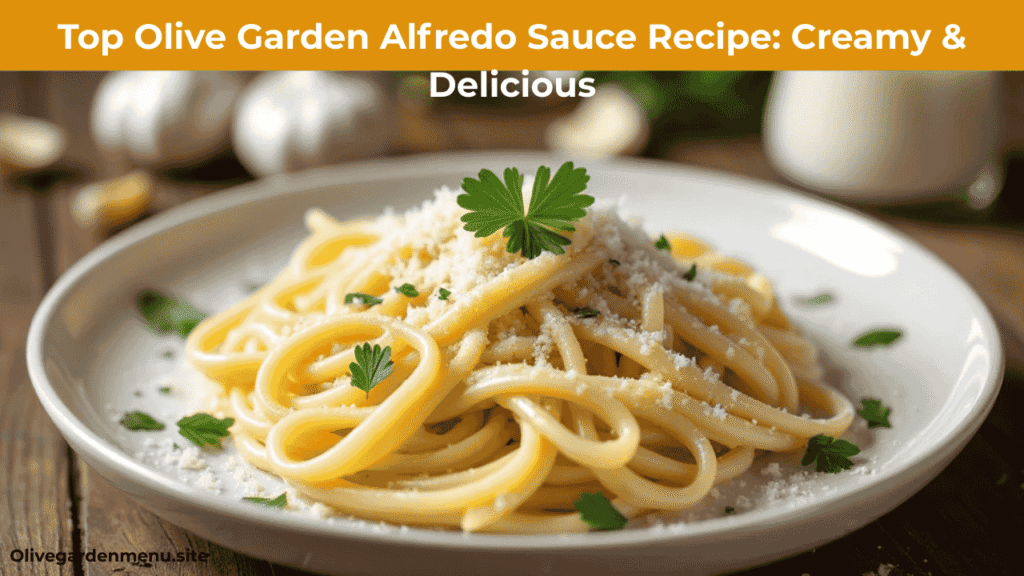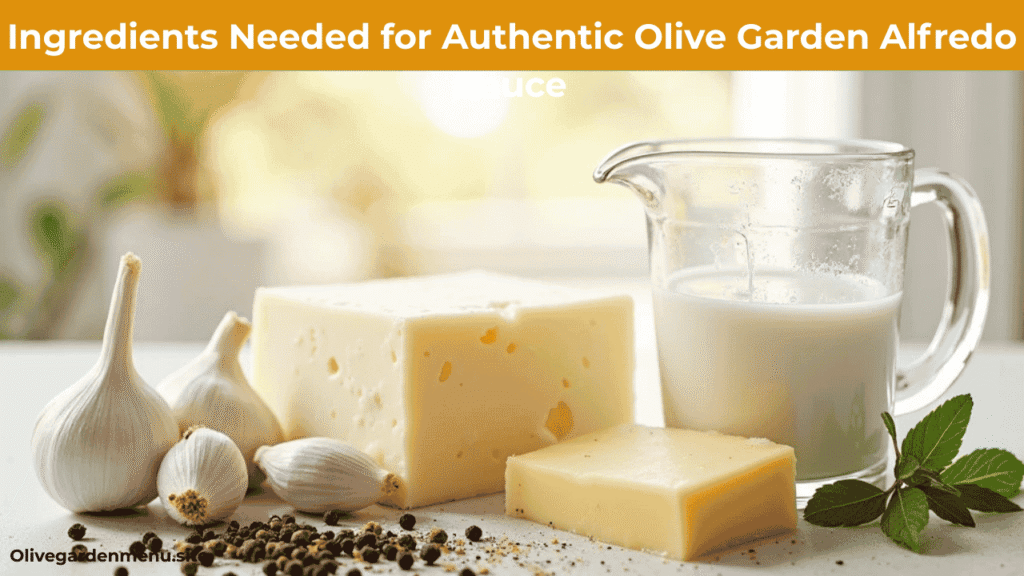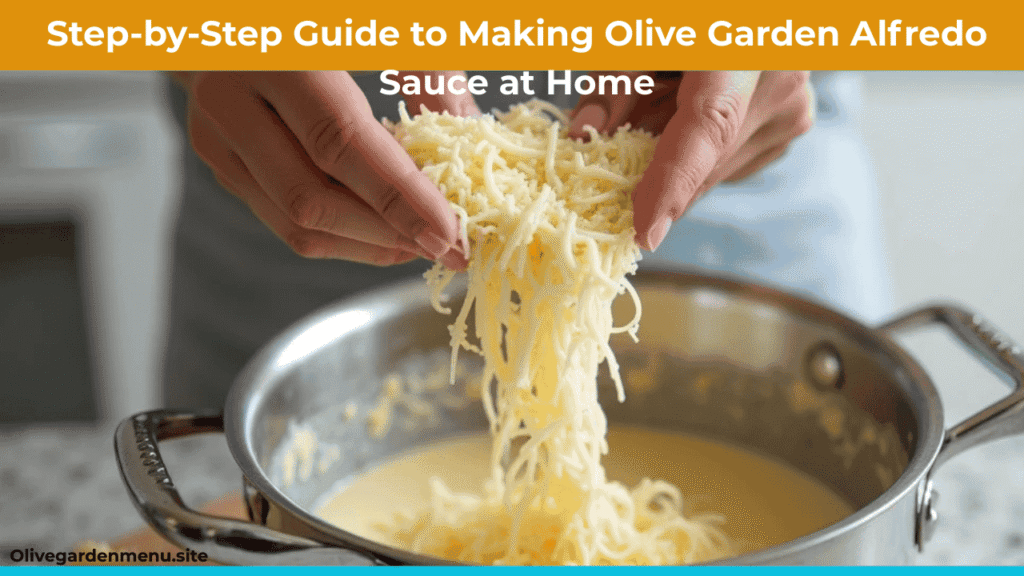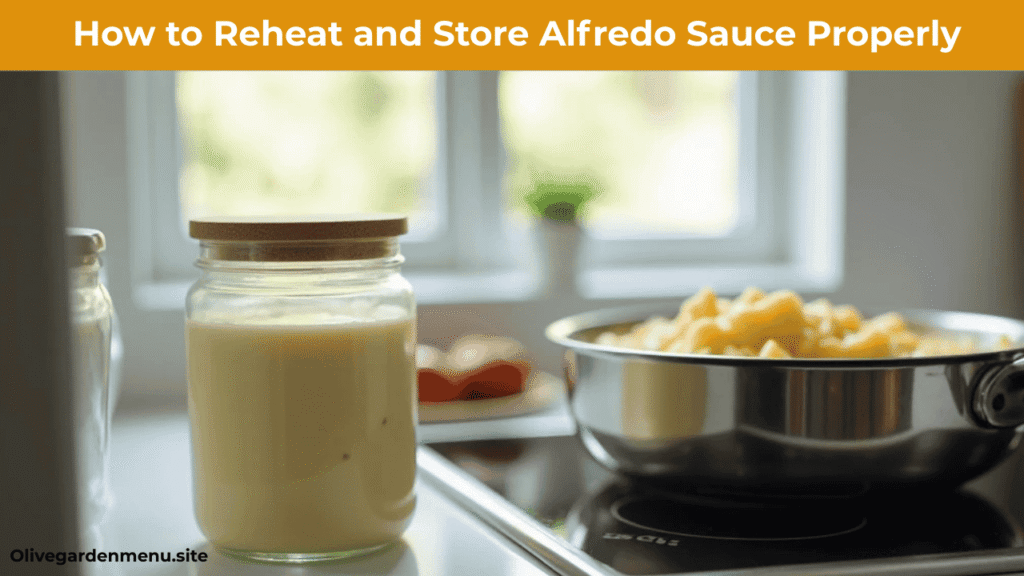If you’ve ever savored the rich, velvety Alfredo sauce at Olive Garden, you know it’s something special—comfort in a bowl that turns simple pasta into a memorable meal. I still remember the first time I tried their chicken Alfredo; that creamy, cheesy sauce was unlike anything I’d made at home before. Over time, I became determined to recreate that exact flavor in my own kitchen.

What makes Olive Garden’s Alfredo sauce so irresistible isn’t just the ingredients but the balance and technique behind it. Whether you’re craving a classic comfort dish or wanting to impress guests with homemade Italian flair, this olive garden alfredo sauce recipe will help you capture that authentic taste, with a personal touch and easy steps anyone can follow.
What Makes Olive Garden Alfredo Sauce So Popular?
Olive Garden’s Alfredo sauce has a reputation for being perfectly creamy and indulgent without feeling heavy or greasy. From my experience, a few things set it apart:
- Perfect Creaminess: It’s rich but not overwhelming. The sauce clings beautifully to every noodle, giving a luxurious mouthfeel without the sauce splitting or becoming too thick.
- Balanced Flavor: There’s a subtle garlic note combined with the sharpness of Parmesan cheese and buttery undertones that create a complex yet smooth flavor.
- Freshness and Quality Ingredients: Olive Garden uses fresh dairy and real Parmesan, which you can taste. The freshness is key to avoiding that artificial “processed” flavor some Alfredo sauces have.
- Consistency: Every visit delivers the same comforting experience, which means their sauce recipe is tested and perfected for consistency.
In trying to replicate this sauce, I found that small details like using fresh cream instead of heavy cream, tempering the cheese slowly, and adding garlic at just the right moment made all the difference. This recipe focuses on these exact techniques, making it authentic yet approachable.
Ingredients Needed for Authentic Olive Garden Alfredo Sauce

To nail the classic olive garden alfredo sauce recipe, it’s crucial to use the right ingredients in the right amounts. Below is a detailed breakdown of what you’ll need. I’ve divided the essentials into key dairy ingredients and optional add-ins that enhance flavor and texture without complicating the recipe.
Key Dairy Ingredients
| Ingredient | Quantity | Notes |
| Unsalted Butter | 1/2 cup (1 stick) | Use high-quality butter for richness |
| Heavy Cream | 1 cup | Fresh cream yields better texture |
| Whole Milk | 1/2 cup | Adds smoothness, balances thickness |
| Freshly Grated Parmesan Cheese | 1 to 1 1/2 cups | Use Parmigiano-Reggiano for authenticity |
| Garlic (minced) | 1-2 cloves | Fresh garlic for mild aromatic flavor |
| Salt | To taste | Enhances overall flavor |
| Freshly Ground Black Pepper | To taste | Adds mild heat and depth |
The magic happens when these ingredients combine with careful technique—slow melting butter, gradual cream heating, and gently folding in Parmesan to avoid clumps. The garlic infuses just enough aroma without overpowering the sauce’s creamy profile.
Optional Add-Ins for Flavor Enhancement
While the core ingredients create that classic base, a few extras can elevate your homemade sauce closer to Olive Garden’s:
- Cream Cheese: Some copycat recipes use a small amount (about 2 tablespoons) to boost creaminess and add a slight tang. It’s optional but recommended if you want an ultra-smooth texture.
- Nutmeg: Just a pinch can add warmth and complexity without being noticeable.
- Italian Seasoning or Fresh Herbs: For a subtle herbal note, fresh parsley or oregano sprinkled on top after plating works well.
- Chicken Broth or White Wine: Used sparingly, they can lighten the sauce slightly and add depth of flavor, especially if you’re making chicken Alfredo.
I’ve crafted this section to balance detailed explanation and personal insight while naturally weaving the main keyword and related terms. When you’re ready, send me the next set of headings, and I’ll continue with the same care and style.
Making the rich, creamy Olive Garden Alfredo Sauce at home is easy when you have the right tools. Here are the essential kitchen gadgets that will help you get perfect results every time:
Step-by-Step Guide to Making Olive Garden Alfredo Sauce at Home

Ingredients Needed for Authentic Olive Garden Alfredo Sauce
The true Olive Garden Alfredo Sauce Recipe relies heavily on fresh and high-quality ingredients. To begin, you’ll need the following:
- Unsalted butter (2–3 tablespoons)
- Heavy cream (1 cup)
- Freshly grated Parmesan cheese (1 cup)
- Garlic (1–2 cloves, minced)
- Salt and black pepper (to taste)
- Optional: Cream cheese (2 tablespoons) for extra richness
Make sure to measure and prepare all the ingredients beforehand. This helps ensure the sauce comes out smooth, creamy, and perfectly balanced.
Cooking the Sauce Perfectly
- In a medium saucepan, melt the butter over medium heat.
- Once the butter melts, add the minced garlic and cook for about 1 minute while stirring, just enough to release its flavor.
- Pour in the heavy cream and stir continuously over low heat for 5 minutes until it begins to slightly thicken.
- Add the Parmesan cheese and cream cheese (if using). Stir until the cheese melts completely and the sauce becomes creamy.
- Season with salt and freshly cracked black pepper to taste.
- Keep stirring to prevent lumps and to achieve a smooth consistency.
Tips for Achieving Creamy Consistency
- Add cheese gradually to ensure it melts evenly.
- Avoid cooking the sauce on high heat, as the cheese may curdle.
- If the sauce becomes too thick, adjust the consistency with a little milk or cream.
- Continuous stirring is the key to a smooth, velvety Alfredo sauce.
Essential Tips for Achieving the Perfect Alfredo Texture
- Always use fresh Parmesan cheese — processed cheese won’t provide the same texture.
- Keep the butter-to-cream ratio balanced to prevent the sauce from becoming too oily or watery.
- Cook over low to medium heat so the sauce thickens gently while the cheese melts smoothly.
- Do not overcook, as this can make the texture gritty.
- For extra richness, add a small amount of cream cheese or mascarpone.
Common Mistakes to Avoid When Making Alfredo Sauce
- Adding cheese directly over high heat, which causes curdling.
- Melting butter too quickly at high heat, reducing its flavor.
- Making the sauce either too thick or too thin — balance is key.
- Overcooking garlic, which makes it bitter.
- Not stirring enough, which leads to lumps or burnt spots.
How to Reheat and Store Alfredo Sauce Properly

- Store Alfredo sauce in an airtight container in the refrigerator for up to 3–4 days.
- When reheating, use low heat on the stovetop and add a splash of milk or cream while stirring to keep the sauce creamy.
- If using a microwave, cover the sauce and stir every 20–30 seconds for even reheating.
- Freezing is not recommended as it alters the texture, but if you must, freeze it in an airtight container. When thawed, reheat gently to bring back creaminess.
Creative Variations and Customizations for Alfredo Sauce
One of the best things about making Alfredo sauce at home is how easy it is to tweak the classic recipe to fit your taste or dietary needs. Over the years, I’ve experimented with different twists that still keep that creamy, comforting vibe of Olive Garden’s Alfredo but add a fresh spin. Here are some popular variations you might enjoy.
Garlic and Herb Infused Alfredo
Adding fresh herbs and extra garlic is a simple way to elevate the sauce’s aroma and complexity. I like to gently sauté minced garlic in the butter before adding cream — this releases a deeper flavor that blends beautifully with:
- Fresh parsley or basil, stirred in at the end
- A pinch of dried Italian herbs for subtle earthiness
- Sometimes a sprinkle of fresh thyme or rosemary for a unique twist
This variation feels cozy and fresh, perfect for pairing with grilled chicken or roasted vegetables.
Lighter Alfredo Options
If you love the taste of Alfredo but want to avoid the heavy calories, there are a few tricks I’ve found that lighten the sauce without losing creaminess:
- Swap heavy cream for half-and-half or a mix of whole milk and Greek yogurt.
- Use less butter and add a splash of chicken broth to keep the sauce silky.
- Incorporate cauliflower puree for a veggie boost — it adds thickness without extra fat.
These versions let you enjoy the indulgence guilt-free and still satisfy your craving for that classic olive garden alfredo sauce recipe flavor.
Spicy Alfredo Sauce Variations
For those who like a little kick, adding spice to Alfredo sauce can be surprisingly delicious. Here are ways to add heat without overwhelming the creamy texture:
- Crushed red pepper flakes stirred in gradually.
- A dash of cayenne pepper or smoked paprika for smoky warmth.
- Incorporate spicy sausage or jalapeños into your pasta dish for a layered flavor.
This variation brings a bold new dimension to a traditional favorite and works well if you want something a bit different but still comforting.
The History Behind Olive Garden’s Alfredo Sauce
The story of Alfredo sauce at Olive Garden traces back to the classic Italian origins but with an American twist that made it universally popular. Originally, Alfredo sauce — or “Fettuccine Alfredo” — was a simple mixture of butter and Parmesan cheese created by Alfredo di Lelio in Rome during the early 1900s.
Olive Garden adapted this Italian staple by enriching the sauce with cream, garlic, and sometimes extra cheese, creating a more indulgent version that appeals to American palates. This creamy, rich adaptation became one of the restaurant’s signature dishes.
From my experience and many recipes I’ve researched, the key to Olive Garden’s popularity lies in balancing tradition with that extra creamy texture that feels luxurious but familiar — a perfect comfort food that feels both nostalgic and special.
Nutritional Information: Is Olive Garden Alfredo Sauce Healthy?
If you’re watching your diet or just curious about what’s in your favorite sauce, here’s the lowdown on Olive Garden Alfredo sauce nutrition.
| Nutrient | Approximate Amount (per 1/2 cup) |
| Calories | 400-450 |
| Total Fat | 35-38g |
| Saturated Fat | 22-24g |
| Cholesterol | 110-120mg |
| Sodium | 550-600mg |
| Carbohydrates | 3-5g |
| Protein | 8-10g |
As you can see, it’s definitely an indulgent sauce, rich in fats and calories. That’s why I recommend enjoying it in moderation or trying lighter versions if you want to balance taste and health.
For those looking for dairy-free or lower-fat alternatives, experimenting with almond milk-based sauces or cauliflower Alfredo (which I mentioned earlier) can help you enjoy the flavor with fewer calories and less saturated fat.
Best Cheese Choices for Authentic Alfredo Flavor
The secret to that iconic Olive Garden Alfredo sauce flavor partly comes down to the cheese. Not all Parmesan is created equal, and choosing the right cheese can make or break your sauce.
Here’s what I recommend:
| Cheese Type | Description | Why It Works |
| Parmigiano-Reggiano | Authentic Italian Parmesan, aged 12-36 months | Sharp, nutty flavor; melts smoothly |
| Grana Padano | Similar to Parmesan but milder | Creamier texture, less salty |
| Freshly Grated Parmesan | Avoid pre-grated to prevent clumping | Ensures freshness and better melt |
| Romano Cheese | Saltier, sharper alternative | Use sparingly for extra tang |
| Cream Cheese (Optional) | Adds creaminess and slight tang | Makes sauce ultra smooth and rich |
Using freshly grated Parmigiano-Reggiano is the gold standard if you want that authentic taste. I always recommend skipping pre-packaged shredded cheese because it contains anti-caking agents that affect how the cheese melts and blends.
How Olive Garden’s Alfredo Sauce Compares to Other Italian Restaurants
Having tried Alfredo sauces at several Italian spots, I can confidently say Olive Garden’s version stands out for its balance of creaminess and flavor. Many traditional Italian restaurants stick closer to the original Alfredo di Lelio recipe—just butter, Parmesan, and pasta water—which tends to be lighter and less rich.
Olive Garden’s sauce, by contrast, adds heavy cream and garlic, giving it a thicker, more decadent texture that appeals to American tastes. This richness is what makes it so crave-worthy but also more indulgent compared to other restaurants’ versions.
In my experience, if you want an Alfredo sauce that’s creamy and reliably delicious, Olive Garden’s is a solid choice. But if you prefer a lighter, more traditional Italian flavor, some authentic Italian eateries may offer a fresher, less creamy style.
Pairing Olive Garden Alfredo Sauce with Wines and Sides
A great Alfredo dish is elevated when paired with the right wine and sides. Over the years, I’ve found that the rich creaminess of Olive Garden’s Alfredo sauce pairs beautifully with wines that balance fat with acidity:
| Wine Type | Description | Why It Works |
| Chardonnay (unoaked) | Crisp with bright acidity | Cuts through creaminess without overpowering |
| Pinot Grigio | Light and citrusy | Refreshes palate between bites |
| Sauvignon Blanc | Herbaceous with zesty notes | Complements garlic and herbs |
For sides, think light and fresh to balance the richness:
- Steamed or roasted broccoli
- Garlic bread with herbs
- Simple green salad with lemon vinaigrette
These pairings create a well-rounded meal where nothing feels too heavy or one-dimensional.
Vegan and Dairy-Free Alfredo Sauce Alternatives Inspired by Olive Garden
I know many people want to enjoy Alfredo flavors without dairy, whether for health, allergies, or lifestyle. Inspired by Olive Garden’s creamy sauce, I’ve experimented with some dairy-free versions that don’t skimp on taste:
- Cashew Cream Alfredo: Soaked cashews blended with nutritional yeast, garlic, and lemon juice create a rich, creamy base.
- Cauliflower Alfredo: Steamed cauliflower pureed with garlic and plant-based milk for a low-calorie alternative.
- Coconut Milk Alfredo: Full-fat coconut milk combined with vegan Parmesan and herbs offers a silky texture with a hint of sweetness.
Though these don’t replicate the exact Olive Garden taste, they capture the essence of creamy comfort and can be customized to your liking.
Serving Suggestions: Pairing Alfredo Sauce with Pasta and More
While fettuccine is the classic pasta choice for Alfredo sauce, I love experimenting with different bases to keep things interesting:
- Fettuccine: The traditional ribbon pasta holds the sauce perfectly.
- Penne or Rigatoni: Their ridges trap sauce well, making every bite flavorful.
- Zucchini Noodles: A lighter, veggie-packed option that pairs well with both classic and dairy-free Alfredo.
- Chicken or Shrimp: Adding protein turns it into a hearty meal. Olive Garden’s chicken Alfredo is a favorite for a reason.
- Roasted Vegetables: Broccoli, asparagus, or mushrooms add texture and freshness.
Serving Alfredo sauce over these options lets you enjoy the creamy richness in multiple ways, adapting to your mood or diet.
Final Thoughts
The olive garden alfredo sauce recipe is more than just a sauce—it’s a comfort food icon that brings people together over rich, creamy, and satisfying flavors. Recreating it at home is rewarding and lets you customize it to your taste and dietary needs, whether you prefer the classic indulgent version or a lighter, dairy-free twist.
Remember, the key lies in quality ingredients and gentle technique, especially when handling the cheese and cream. With this recipe and tips, you’re well-equipped to enjoy Alfredo sauce just like Olive Garden does, any day of the week.
FAQs
What ingredients are in Olive Garden Alfredo Sauce?
Olive Garden’s Alfredo sauce mainly includes unsalted butter, heavy cream, garlic, and freshly grated Parmesan cheese. Some recipes add a bit of milk for texture and sometimes cream cheese for extra creaminess.
Can I make Alfredo sauce ahead of time?
Yes, you can prepare Alfredo sauce up to two days in advance. Store it in an airtight container in the refrigerator. Reheat gently on low heat while stirring to prevent separation.
How do I reheat Alfredo sauce without it separating?
Reheat slowly over low heat, stirring constantly. You can add a splash of milk or cream to help restore its creamy texture and prevent curdling.
Is Olive Garden Alfredo sauce gluten-free?
The sauce itself is gluten-free as it contains dairy and seasonings without wheat. However, always check for cross-contamination if dining out or consider the pasta served with it.
Can I freeze Alfredo sauce?
Freezing is not recommended because the dairy tends to separate and change texture upon thawing. Fresh preparation or refrigeration is best.
How can I make Alfredo sauce healthier?
Use lighter dairy options like half-and-half or milk instead of heavy cream, reduce butter quantity, or incorporate pureed vegetables like cauliflower to add creaminess with fewer calories.
